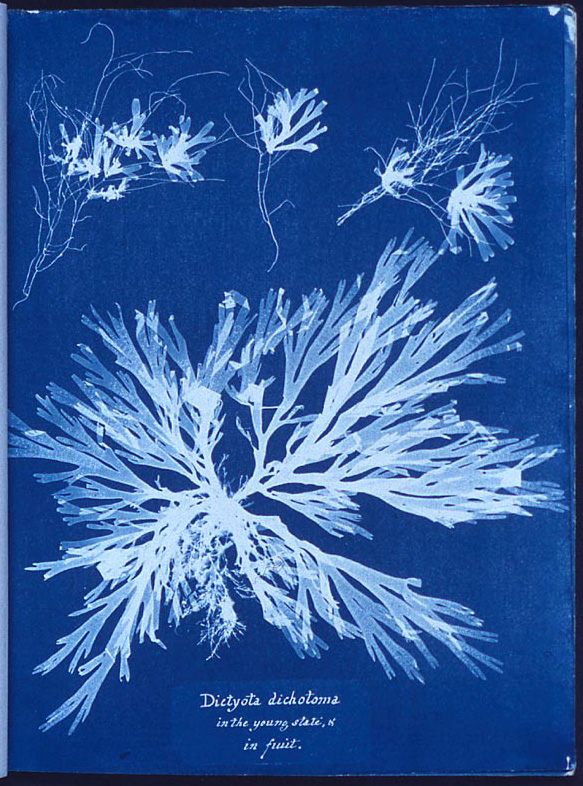Sun printing on:
[Wikipedia]
[Google]
[Amazon]
 Sun printing may refer to various printing techniques which use sunlight as a developing or fixative agent.
Sun printing may refer to various printing techniques which use sunlight as a developing or fixative agent.
How to Dye and Paint Fabric with Light
/ref> Unlike other vat dyes which use oxygen to develop their color, Inkodyes are developed by light. These dyes are suspended in leuco form appearing colorless until they are exposed to UV. Their usage resembles that of cyanotype, but unlike cyanotype Inkodyes are primarily used on textiles and exist in a full range of colors. Exposure times vary from 3 to 15 minutes depending on the desired color and intensity of light. Once exposed, the sensitized material is washed in soapy water to remove dye from unexposed areas. Such dyes are typically used by craftspeople, fabric printers and artists and can be printed with photographic negatives, resist paste or through a
Inkodye - Light-sensitive vat dyes
{{DEFAULTSORT:Sun Printing Photographic processes Non-impact printing Printmaking
 Sun printing may refer to various printing techniques which use sunlight as a developing or fixative agent.
Sun printing may refer to various printing techniques which use sunlight as a developing or fixative agent.
Techniques
Cyanotype
Cyanotype
The cyanotype (from Ancient Greek κυάνεος - ''kuáneos'', “dark blue” + τύπος - ''túpos'', “mark, impression, type”) is a slow-reacting, economical photographic printing formulation sensitive to a limited near ultraviolet ...
, also referred to as "blueprinting", is the oldest non-silver photographic printing process. It involves exposing materials which have been treated with a solution of potassium ferricyanide
Potassium ferricyanide is the chemical compound with the formula K3 e(CN)6 This bright red salt contains the octahedrally coordinated 3−.html" ;"title="e(CN)6sup>3−">e(CN)6sup>3− ion. It is soluble in water and its solution shows some g ...
and ferric ammonium citrate to a UV light source such as the sun. Negative or positive images can be obtained by blocking UV light from reaching the sensitized material. For example, a negative image can be produced by placing a leaf upon paper treated with this solution and exposing to sunlight for 10 to 20 minutes. The paper will retain the image of the leaf after it has been rinsed with water. Once the paper dries, parts that were exposed to the sun will turn a shade of Prussian blue (ferric ferrocyanide), while parts that were covered by the leaf will remain white.
Light-sensitive vat dyes
A specialized type ofvat dye
Vat dyes are a class of dyes that are classified as such because of the method by which they are applied. Vat dyeing is a process that refers to dyeing that takes place in a bucket or vat. The original vat dye is indigo, once obtained only from pl ...
called Inkodye is also used for sun-printing due to its light-sensitive quality./ref> Unlike other vat dyes which use oxygen to develop their color, Inkodyes are developed by light. These dyes are suspended in leuco form appearing colorless until they are exposed to UV. Their usage resembles that of cyanotype, but unlike cyanotype Inkodyes are primarily used on textiles and exist in a full range of colors. Exposure times vary from 3 to 15 minutes depending on the desired color and intensity of light. Once exposed, the sensitized material is washed in soapy water to remove dye from unexposed areas. Such dyes are typically used by craftspeople, fabric printers and artists and can be printed with photographic negatives, resist paste or through a
silk screen
Screen printing is a printing technique where a mesh is used to transfer ink (or dye) onto a substrate, except in areas made impermeable to the ink by a blocking stencil. A blade or squeegee is moved across the screen to fill the open me ...
.
Potassium dichromate
Sun printing may also refer to aphotographic
Photography is the art, application, and practice of creating durable images by recording light, either electronically by means of an image sensor, or chemically by means of a light-sensitive material such as photographic film. It is employed ...
process using potassium dichromate
Potassium dichromate, , is a common inorganic chemical reagent, most commonly used as an oxidizing agent in various laboratory and industrial applications. As with all hexavalent chromium compounds, it is acutely and chronically harmful to health ...
which produces a negative plate for conventional lithographic printing. The process uses a film of gelatine
Gelatin or gelatine (from la, gelatus meaning "stiff" or "frozen") is a translucent, colorless, flavorless food ingredient, commonly derived from collagen taken from animal body parts. It is brittle when dry and rubbery when moist. It may also ...
spread on a flat and rigid surface. This is coated with a dilute solution of potassium dichromate and dried in low light conditions. A translucent positive is secured in tight contact with the treated gelatine layer and exposed to bright sunlight for a period of up to 30 minutes. During this time the sunlight and potassium dichromate tan the gelatine exposed to light. The plate is developed by washing in warm water and removing the untanned gelatine. Once dry, a relief print
Relief printing is a family of printing methods where a printing block, plate or matrix, which has had ink applied to its non-recessed surface, is brought into contact with paper. The non-recessed surface will leave ink on the paper, whereas t ...
is revealed on the plate. The surface can be inked and printed in a hand press to produce any number of identical prints of the original subject.
References
Further reading
*External links
Inkodye - Light-sensitive vat dyes
{{DEFAULTSORT:Sun Printing Photographic processes Non-impact printing Printmaking